Yarn-dyed fabric is a textile marvel that elevates the art of weaving. Unlike its piece-dyed counterpart, this method involves immersing individual yarns in dye before they are woven, resulting in vivid, long-lasting colors.
The distinctive process allows for intricate patterns and designs, creating a visual tapestry of depth and texture. This technique finds its roots in traditional craftsmanship, cherished for its ability to produce fabrics of exceptional quality.
Yarn-dyed creations adorn a spectrum of products, from elegant apparel to exquisite home textiles. In this fusion of technique and artistry, yarn-dyed fabric emerges as a testament to the enduring allure of textile craftsmanship.
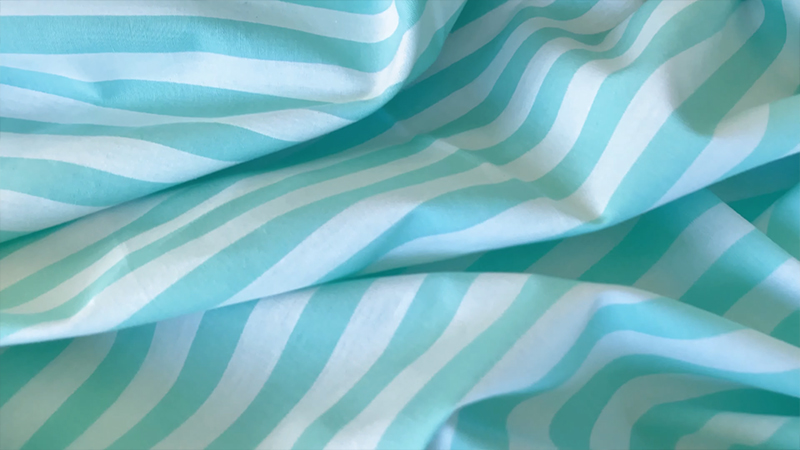
What Is Yarn Dyed Fabric?
Yarn-dyed fabric is a type of textile that is woven from yarns that have been dyed before they are woven into the fabric. This is in contrast to piece-dyed fabric, where the fabric is woven first and then dyed as a whole.
Yarn-dying is a specialized dyeing process that offers several advantages and is commonly used in the production of high-quality and intricately patterned fabrics.
Here are some key characteristics and benefits of yarn-dyed fabrics:
Enhanced Color Fastness
Yarn-dyed fabrics owe their impressive color retention to the pre-dyeing process. Each individual yarn is thoroughly saturated with color before it’s woven into the fabric.
This means that the dye penetrates deeply into the fibers, resulting in colors that are less likely to fade or bleed, even after numerous washes or prolonged exposure to sunlight.
Intricate Patterns and Designs
The yarn-dying technique offers a level of design intricacy that is difficult to achieve through other methods.
Different yarns can be dyed in a multitude of colors, and then meticulously woven together to create complex patterns, be it classic stripes, elegant checks, or elaborate plaids.
The end result is a fabric with a visually stimulating, multi-dimensional texture that catches the eye.
Durability
Yarn-dyed fabrics are renowned for their exceptional durability. The color remains vibrant, even with regular use and laundering.
Additionally, the structure of the fabric retains its integrity over time, making it resistant to fraying or wear and tear.
Versatility
Yarn-dyed fabrics can be crafted from a wide array of materials, ranging from natural fibers like cotton, linen, silk, and wool to synthetic fibers.
This diversity in material options allows for a broad range of textures and properties, making yarn-dyed fabrics suitable for an extensive array of applications, from lightweight summer garments to heavy-duty upholstery.
High-Quality Look and Feel
The depth of color and intricate patterns associated with yarn-dyed fabrics imbue them with an aura of luxury and refinement.
The fabric feels substantial, conveying a sense of quality and sophistication. This makes it a preferred choice for discerning consumers and designers seeking a premium finish.
Customization
The yarn-dying process provides manufacturers and designers with a greater degree of control over the final appearance of the fabric.
This enables them to create custom fabrics tailored to specific design requirements, ensuring that the end product perfectly embodies their vision.
Reduced Environmental Impact
Yarn-dying often involves fewer chemicals and less water compared to piece-dying. This results in a reduced environmental footprint.
Moreover, the longevity of yarn-dyed fabrics means they need to be replaced less frequently, contributing to a more sustainable approach to fashion and interior design.
Yarn Dyeing Process
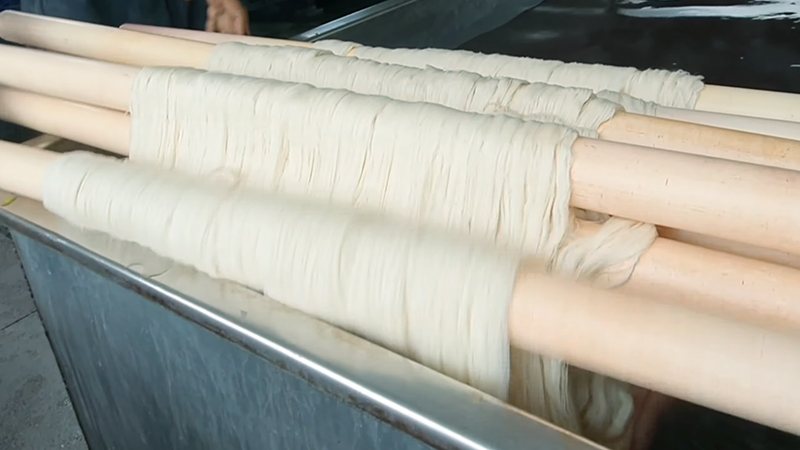
The yarn dyeing process is a crucial step in creating yarns with vibrant and lasting colors. It involves applying dye to the individual yarns before they are woven into fabric.
This method allows for intricate patterns and designs to be woven, creating a unique and visually appealing finished product.
Here is an overview of the yarn dyeing process:
Selection of Yarn
The process begins with the selection of the type of yarn to be dyed. Yarns can be made from various materials, including natural fibers like cotton, wool, silk, or linen, as well as synthetic fibers like polyester or nylon.
Skeining and Scouring
The yarn is often wound onto large spools or cones, known as skeins. Before dyeing, the yarn must be thoroughly cleaned to remove any impurities or natural oils that may hinder the dye’s absorption.
This process, known as scouring, involves washing the yarn with mild detergents or other cleaning agents.
Preparation of Dye Bath
The dyeing process requires the preparation of a dye bath, which is a mixture of water, dye, and any necessary additives like fixing agents or leveling agents. The specific dye formulation depends on factors such as the type of yarn and desired color.
Dyeing
The skeins of yarn are immersed in the dye bath. The dye bath is heated, and the temperature, pH level, and duration of the dyeing process are carefully controlled. The yarn absorbs the dye, and the color becomes permanently set in the fibers.
Rinsing and Washing
After the dyeing process, the yarn is removed from the dye bath and thoroughly rinsed to remove any excess dye. This is followed by a washing step to further remove any residual dye and to ensure colorfastness.
Drying
Once washed, the dyed yarn is dried. This can be achieved through various methods, including air-drying, machine drying, or in some cases, using specialized drying equipment.
Quality Control
The dyed yarn undergoes quality checks to ensure that the color is consistent and that there are no defects. This may include visual inspections, color matching against a standard, and sometimes even laboratory testing.
Packaging
After passing quality control checks, the dyed yarn is typically wound onto spools or cones for ease of handling and storage. It is then labeled and packaged for distribution.
Different Types of Yarn Dyeing Techniques
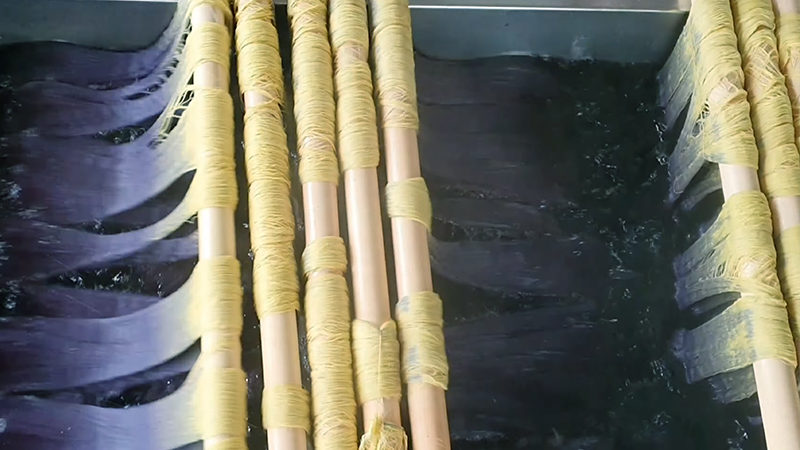
Yarn dyeing is a textile dyeing process that involves coloring the yarns before they are woven or knitted into fabric. There are various techniques for yarn dyeing, each with its own characteristics and applications.
Here are some of the different types of yarn dyeing techniques:
Skein Dyeing
- Process: In skein dyeing, hanks or skeins of yarn are wound into loops and then immersed in a dye bath. This method allows for even dye penetration as the dye can reach all parts of the yarn.
- Applications: Skein dyeing is commonly used for dyeing yarns that will be used in hand-knitting, crocheting, or for creating multi-colored or variegated yarns for various textile applications.
Package Dyeing
- Process: Yarn is wound onto cones, tubes, or spools and then dyed by immersing these packages into a dye bath. It’s a more efficient method for dyeing large quantities of yarn.
- Applications: Package dyeing is often used for dyeing yarns intended for industrial weaving or knitting processes.
Space Dyeing
- Process: Space dyeing involves applying different colors of dye to specific sections or “spaces” of the yarn. This creates a variegated or streaked appearance in the final product.
- Applications: Space dyeing is frequently used for creating unique, multicolored yarns for artistic and fashion-forward applications, such as hand-dyed yarns for knitting and weaving.
Skein Printing
- Process: This technique involves applying dyes in specific patterns or designs directly onto yarn skeins using various printing methods, such as screen printing or hand painting.
- Applications: Skein printing allows for intricate and customized patterns on yarn, making it popular for creating yarns with unique designs and color combinations.
Beam Dyeing
- Process: Beam dyeing is primarily used for dyeing yarns that are part of the warp in weaving. The yarn is wound onto a large beam, which is then submerged in a dye bath.
- Applications: This method is commonly used in the textile industry for dyeing yarns that will be used in the warp of woven fabrics.
Package Space Dyeing
- Process: Package space dyeing combines elements of both package dyeing and space dyeing. Yarn is wound onto packages and then different sections of the package are dyed in various colors to achieve a unique, variegated effect.
- Applications: It is used to create multicolored, space-dyed yarns with a controlled and consistent appearance.
Beam Space Dyeing
- Process: Similar to beam dyeing, but in this case, different sections of the beam are dyed with different colors to create a space-dyed effect.
- Applications: Primarily used in the textile industry for producing warp yarns with a streaked or variegated appearance.
Cross Dyeing
- Process: Cross-dyeing involves using different dyes for various fiber components within a blend. For example, if a yarn blend contains both cotton and polyester, cross-dyeing can be used to achieve different colors on each fiber type.
- Applications: It’s employed when working with blended yarns to create unique color effects by dyeing different fibers within the blend.
Common Types of Yarn Dyed Fabrics
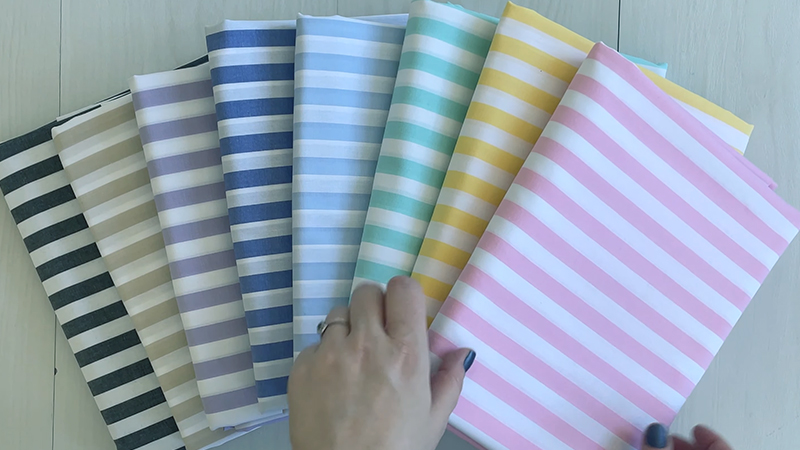
There are several types of yarn-dyed fabrics, each distinguished by the type of yarn used, the weaving pattern, and the dyeing technique.
Here are some common types:
Madras
Madras is a lightweight, plain-woven fabric that originated in the city of Chennai (formerly known as Madras) in India. It is typically made of cotton and is known for its bright and distinctive plaid patterns.
Gingham
Gingham is a balanced plain-woven fabric, often made of cotton, with a checkered pattern formed by horizontal and vertical stripes of equal width. The checks can be of various colors and sizes.
Seersucker
Seersucker is a puckered cotton fabric that is woven in a way that causes some threads to bunch together, creating a wrinkled, textured effect. It is commonly used for warm-weather clothing due to its breathability.
Chambray
Chambray is a plain-woven fabric made of cotton, characterized by a white weft and a colored warp, resulting in a denim-like appearance. It is lightweight and often used for casual shirts and dresses.
Tweed
Tweed is a thick, rough-textured fabric often made of wool. It is known for its intricate, multicolored patterns and is commonly used for outerwear like jackets and coats.
Houndstooth
Houndstooth is a distinctive checked pattern characterized by broken, jagged checks. It can be found in a variety of fabrics, including wool, cotton, and synthetic blends.
Jacquard
Jacquard fabrics are characterized by intricate, multicolored patterns that are woven into the fabric using a special loom known as a Jacquard loom. These patterns can be quite elaborate and are often used for high-end textiles.
Tartan
Tartan is a type of woven fabric associated with Scottish culture, characterized by a pattern of crisscrossed horizontal and vertical bands in multiple colors. Each specific tartan pattern is associated with a particular Scottish clan.
Applications of Yarn Dyed Fabric
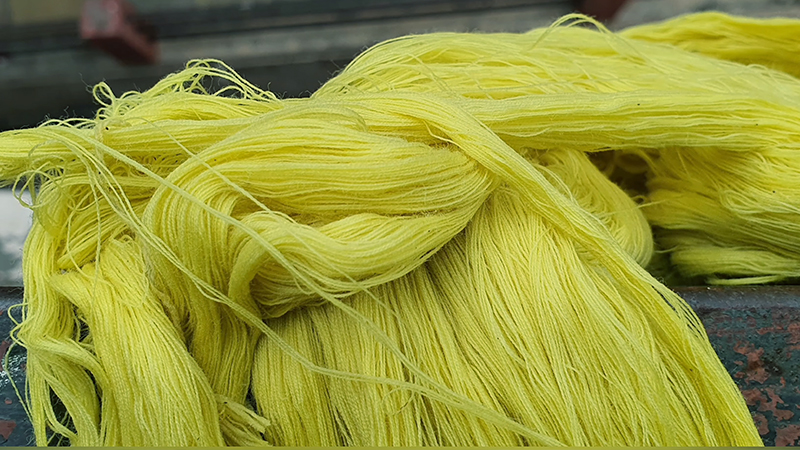
Yarn-dyed fabrics find applications in a wide range of industries and products due to their versatility, durability, and aesthetic appeal.
Here are some common applications of yarn-dyed fabrics:
Apparel
- Shirts: Yarn-dyed fabrics are commonly used in the production of dress shirts, casual shirts, and blouses, offering a crisp and polished appearance.
- Dresses: Yarn-dyed fabrics with intricate patterns and vibrant colors are favored for creating stylish dresses.
- Trousers and Pants: These fabrics can be used to make durable and comfortable pants for both formal and casual wear.
Home Textiles
- Curtains and Drapes: Yarn-dyed fabrics are a popular choice for window treatments, as they can feature elegant patterns and colors that complement interior décor.
- Upholstery: Durable yarn-dyed fabrics are often used for upholstering furniture, providing both style and resilience.
- Table Linens: Tablecloths, placemats, and napkins made from yarn-dyed fabrics add a touch of sophistication to dining spaces.
Bedding
- Bed Linens: Yarn-dyed cotton or linen bed linens offer comfort and a luxurious appearance for bedding sets.
- Blankets and Throws: Yarn-dyed fabrics can also be used in the production of warm and cozy blankets.
Accessories
- Ties: Yarn-dyed silk or microfiber is often used to make neckties and bowties, showcasing intricate patterns and rich colors.
- Scarves: Yarn-dyed fabrics in various materials can be used to create stylish scarves for both fashion and warmth.
Bags and Accessories
- Handbags and Totes: Yarn-dyed fabrics are used to create stylish and durable handbags and tote bags.
- Wallets and Pouches: Small accessories like wallets and pouches can also benefit from the longevity of yarn-dyed fabrics.
Children’s Clothing
- Children’s Wear: Yarn-dyed fabrics are often used in children’s clothing, such as dresses, shirts, and shorts, offering durability and vibrant colors that withstand active play.
- Workwear: Yarn-dyed fabrics are used for work uniforms and professional attire where a neat and polished appearance is important.
Crafts and Home Decor
- Quilting: Yarn-dyed fabrics are popular choices for quilting projects due to their colorfastness and variety of patterns.
- Throw Pillows: Decorative pillows and cushion covers often feature yarn-dyed fabrics, adding texture and style to home decor.
Special Occasion Garments
- Wedding Dresses: Yarn-dyed silk and lace fabrics are used in the creation of exquisite wedding dresses and bridal gowns.
- Formal Wear: Yarn-dyed fabrics play a role in the construction of formal attire such as tuxedos and evening gowns.
FAQs
What is Yarn-Dyed Fabric?
Yarn-dyed fabric is a type of textile where the individual yarns are dyed before being woven into fabric.
How is Yarn-Dyed Fabric Different from Piece-Dyed Fabric?
Yarn-dyed fabric is dyed before weaving, while piece-dyed fabric is dyed after the fabric is woven.
What are the Advantages of Yarn-Dyed Fabric?
Yarn-dyed fabric offers enhanced color fastness, intricate patterns, increased durability, and a premium look and feel.
What Types of Yarn-Dyed Fabrics Are Commonly Used?
Common types of yarn-dyed fabrics include madras, gingham, seersucker, chambray, tweed, houndstooth, jacquard, tartan, stripes, flannel, and denim, among others.
What are Some Applications of Yarn-Dyed Fabric?
Yarn-dyed fabrics are used in a wide range of products, including apparel, home textiles, accessories, crafts, and more.
To Recap
The yarn-dyed fabric stands as a testament to textile craftsmanship. Through a meticulous process of dyeing individual yarns before weaving, it achieves a level of vibrancy and colorfastness that sets it apart.
This technique permits intricate patterns and designs, lending depth and sophistication to a variety of textiles.
Yarn-dyed fabrics find versatile applications in clothing, home furnishings, and accessories, gracing them with a premium, long-lasting appeal. Their durability, customization potential, and reduced environmental impact further underscore their significance in the textile industry.
As a fusion of artistry and functionality, yarn-dyed fabric continues to be cherished for its enduring quality and aesthetic excellence.
Leave a Reply